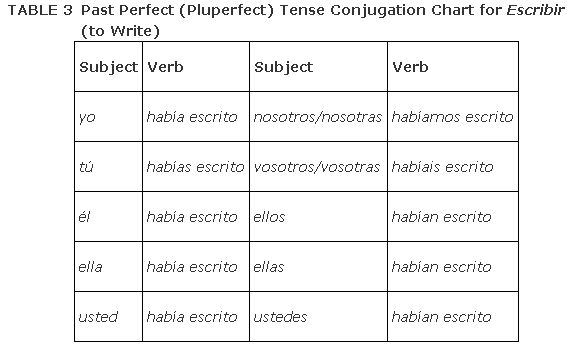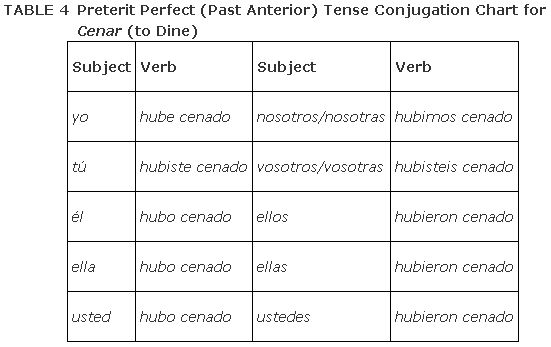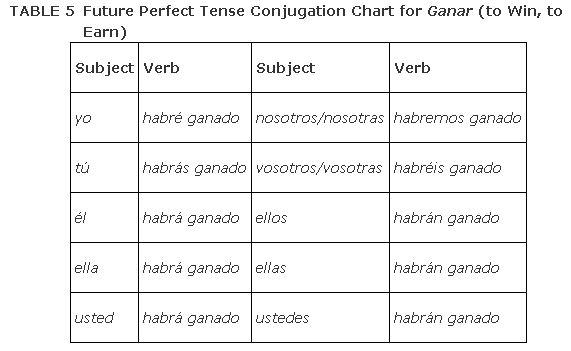The verb
haber is placed in front of a “pure past participle” to create a compound tense. The past participle never changes, but the helping verb must be conjugated to agree with the subject. The tense in which the helping verb is conjugated will determine which of the compound tenses is being constructed.
Table presents the verb haber alone, but in reality, any form of the helping verb haber is almost always followed by a past participle.

See Table for an example of haber being used to create the present perfect tense. Notice that only the conjugated forms of haber change; the past participle form does not change.

The present perfect tense illustrated above is translated as: “I have called,” “you have called,” “we have called,” “they have called,” and so on.
Use the present perfect to indicate that the action of the verb has been completed prior to the present. The present tense conjugation of haber places the point of view in the present but the perfect tense indicates completion. For this reason, the present perfect can actually be used like the preterit to indicate “completedness.” For example, Yo he estudiado (I have studied) in the present perfect expresses the same meaning as Yo estudié (I studied) in the preterit but focuses a little more on the fact that the action is presently completed.
The past perfect (pluperfect) tense is formed like the present perfect except that the helping verb is conjugated in a past tense. But, because there are two simple past tenses in Spanish, you must know that the imperfect tense rather than the preterit is used to create what is called the pluperfect tense. The imperfect tense conjugation of the verb haber is used with the past participle of the main verb. Notice in Table that the imperfect tense forms of the helping verb are all regular.

The past perfect tense illustrated above is translated as: “I had written,” “you had written,” “he had written,” “we had written,” “they had written,” and so on.
The past perfect (pluperfect) tense is used when you are speaking about a time in the past and you want to indicate that something had already been completed before that time. For example,
- Yo había llamado dos veces antes de visitarles ayer.
- I had called twice before visiting them yesterday.
establishes that you are referring to a past time.
The pluperfect explained above is also called the past perfect because it is what a Spanish speaker will naturally use to express the fact that an action was already completed at some point in the past. When the past participle is used with a helping verb conjugated in the preterit rather than the imperfect, the tense is called the preterit perfect or past anterior. The preterit perfect expresses the same idea as the past perfect but is rarely used in spoken Spanish. You are most likely to encounter the preterit perfect in literature, where it is easy to understand. You will probably be safe to use the past perfect tense consistently in spoken Spanish and need only be aware that the preterit perfect illustrated in Table has the same meaning.

Because there is only one past tense in English, the preterit perfect tense is translated the same as the imperfect: “I had dined,” “you had dined,” “he had dined,” “we had dined,” “they had dined,” and so on.
The future perfect tense is predictably created by using the future tense of the helping verb with the past participle. Notice in Table that haber is one of the few verbs that is irregular in the future tense.

The future perfect tense illustrated above is equivalent to the following English expressions: “I will have earned,” “you will have earned,” “she will have earned,” “they will have earned,” and so on.
The future perfect is used to express an action in the future that will be completed before another action that is yet to occur. For example,
- Para el fin de semana, yo habré leído su libro.
means
- By the end of the week, I will have read his book.
The adverb ya (“already”) is often used with the future perfect. On standardized tests, ya in front of the blank may be a clue to use the future perfect tense, although other tenses may also be appropriate. For example,
- Ellos ya habrán terminado su clase cuando reparen el acondicionador de aire.
means
- They already will have finished their class when they repair the air conditioner.
The future tense is sometimes used to express conjecture or the probability of an action occurring in the present. The future perfect tense can be used in a similar fashion to express the probability that an action has currently been completed:
- Ellos habrán llegado al aeropuerto.
- They have arrived at the airport. (probably)
- Ella habrá llamado para hacer reservaciones.
- She has called to make reservations. (supposition)
The conditional conjugation of haber is completely regular. When used with a past participle, the result is a statement contrary to reality; the action of the verb would have been completed if some condition had been met: “I would have done something if …” This is called the conditional perfect.
The conditional perfect tense illustrated above is translated as: “I would have gone,” “you would have gone,” “she would have gone,” “we would have gone,” “they would have gone,” and so on.
The conditional perfect can also be used to express probability or conjecture about the completion of an action prior to some point in the past:
- El habría ganado una beca antes de asistir a esa universidad.
- He would have won a scholarship before attending that university. (I bet)
- La jefe le habría prometido el puesto cuando empezó a trabajar aquí.
- The boss must have promised him the position when he started to work here. (pure conjecture)
|
|
|
|
|
|
|
|
|
|
|
|
|
|
|
|
|
|
|
|
|
|
|
|
|
|
|
|
|
|
|
|
|
|
|